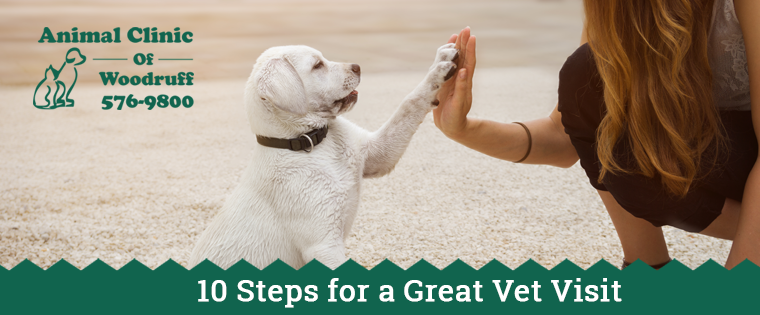Visiting the veterinarian can be stressful for both pets and their people. From navigating crates and car rides to sitting in waiting rooms and on the examination table, there are plenty of places where problems can come up. So we’ve come up with a list of steps, inspired by the American Veterinary Medical Association’s list, to help make veterinary visits more pleasant for everyone.
- Ensure your pet is comfortable traveling in a car and/or in a crate. Don’t make visits to the vet the only time your pet is asked to travel this way. Practicing car rides and times in the crate that end in something fun – like a trip to the dog park or a special treat when done – will keep your pet from negatively associating a ride with a vet visit.
- Bring your cat into the vet’s office in a carrier. Bring dogs on a leash. Please don’t simply carry in animals. This will ensure your pet is under control—for his safety and others’.
- Arrive on time or a few minutes early. Late arrivals may mean your appointment has to be canceled.
- Know your pet’s health history or send it in advance. Your vet, just like your personal doctor, needs to know the history of your pet’s vaccinations and health issues. If you’re starting at a new vet, have your previous one fax over records, or bring them in yourself. And most importantly, make sure that the person who brings in your pet knows your pet’s health history, current medicines and any current problems.
- Be ready to explain any problems or concerns (again, the person who knows this best should bring in the pet). Your observations can really help your vet understand what’s going on, especially since pets often act differently at the vet than they do at home.
- Know the list of medications your pet is on and the schedule for taking them. Also know the brand of food you give them and how much they eat. If you have trouble remembering, simply write these down and show them to your vet – or even take a photo on your phone.
- Avoid distractions during a veterinary appointment. Your vet needs to spend time talking to you and caring for your pet. Don’t use your cell phone.
- Ask questions and keep asking until you fully understand what’s going on and how best to care for your pet. Some great questions include: “When should I be concerned and come back in?” “How long do I need to continue this medication?” and “What are other signs I should watch for?”
- To help you understand any conditions or ailments, ask for brochures, hand-outs and reputable online sources to learn more. Don’t go home and rely on friends or families to explain their pets’ issues – use trusted resources from the vet.
- Follow the veterinarian’s recommendations. Take medications through to completion. Follow rules for isolation or rest. Come in for the follow-up appointment. These steps ensure that the problem your vet tried to solve will be more likely to improve, and you’ll prevent things from getting worse.
Don’t let concern about the vet visit prevent you from coming in. If you are worried your dog or cat can’t handle a visit to the vet, please contact our veterinary office in Woodruff, S.C., to talk through the problem and see how we can help. All animals need to have regular veterinary visits.




